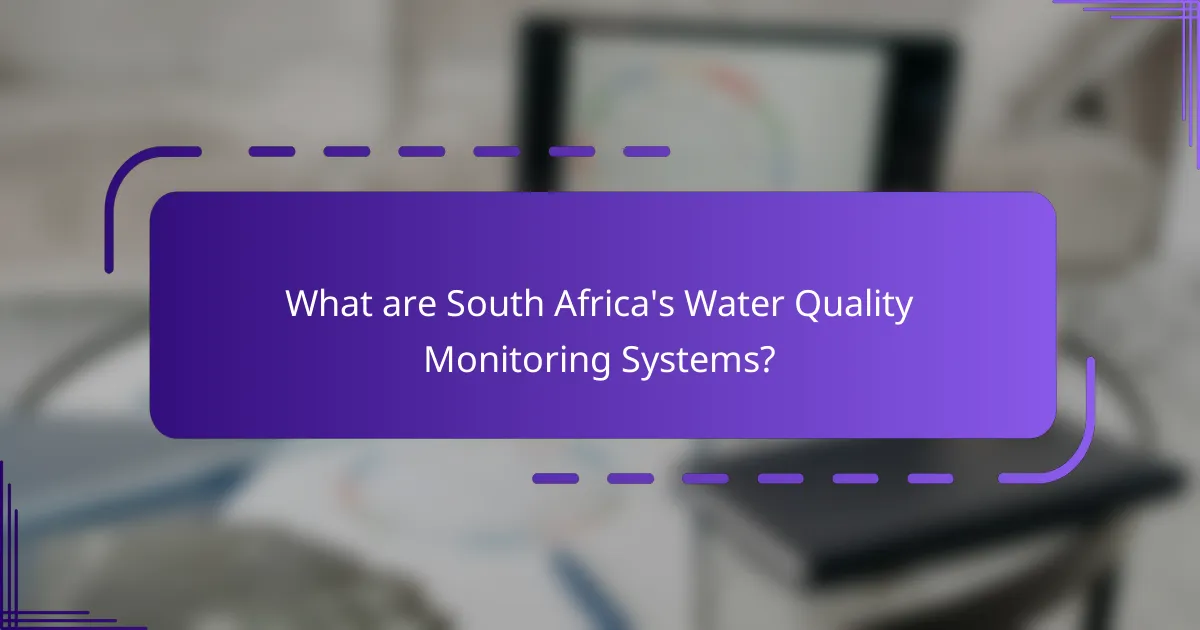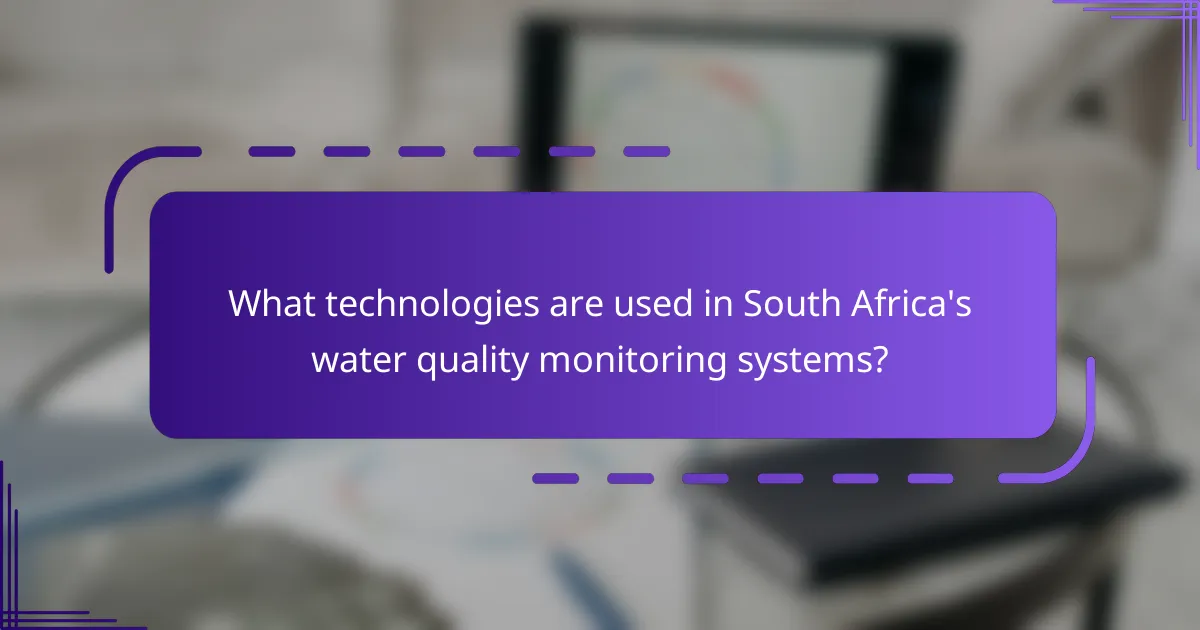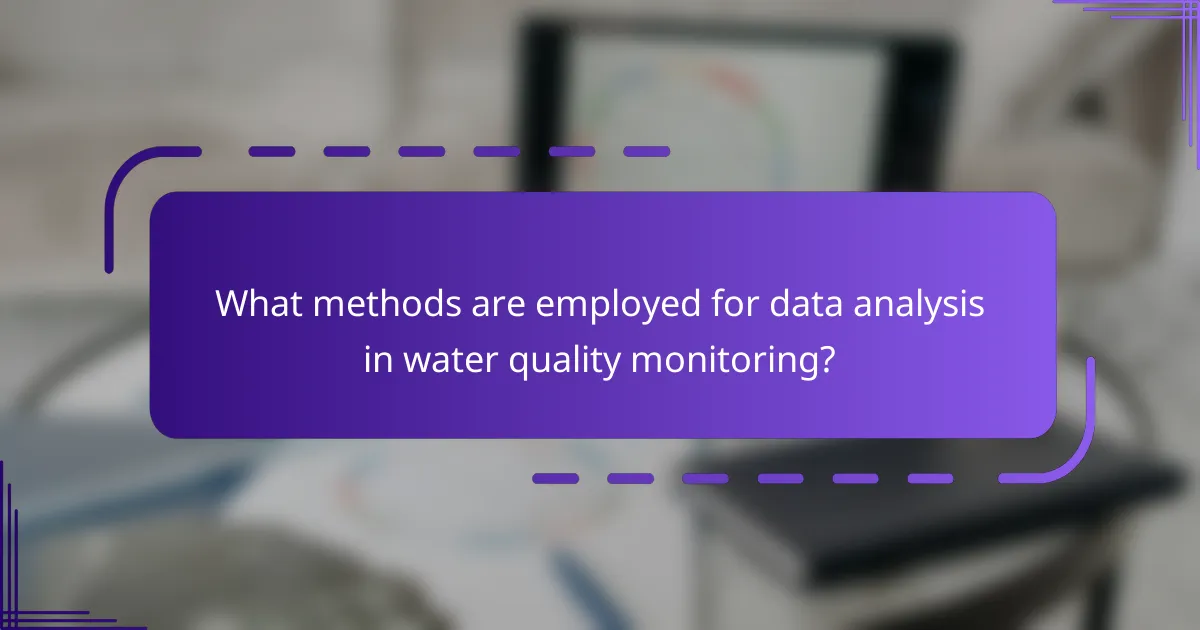South Africa’s Water Quality Monitoring Systems are comprehensive frameworks established to assess and manage water quality nationwide. These systems incorporate advanced technologies such as remote sensing, in-situ sensors, and automated sampling systems to collect and analyze water samples, ensuring compliance with standards set by the Department of Water and Sanitation. Key initiatives include the National Water Quality Monitoring Programme and regional monitoring efforts, which focus on measuring critical parameters like pH, turbidity, and microbial content. The article explores the methodologies employed in data analysis, including statistical analysis, machine learning, and Geographic Information Systems (GIS), which enhance the accuracy and effectiveness of water quality monitoring and support informed decision-making for water resource management and public health protection.

What are South Africa’s Water Quality Monitoring Systems?
South Africa’s Water Quality Monitoring Systems are frameworks designed to assess and manage water quality across the nation. These systems utilize various technologies and methodologies to collect and analyze water samples. They aim to ensure compliance with water quality standards set by the Department of Water and Sanitation. Key components include the National Water Quality Monitoring Programme and regional monitoring initiatives. These programs involve regular sampling at strategic sites to measure parameters such as pH, turbidity, and microbial content. Data collected is analyzed to identify pollution sources and trends over time. The findings support decision-making for water resource management and public health protection.
How do these systems function in monitoring water quality?
Water quality monitoring systems function by using various technologies to assess the chemical, physical, and biological parameters of water. These systems often include sensors and sampling devices that collect data in real-time. They measure attributes such as pH, turbidity, dissolved oxygen, and contaminants. Data is transmitted to central databases for analysis. Advanced algorithms process this information to identify trends and anomalies. Regular calibration of sensors ensures accuracy in readings. These systems also support regulatory compliance by providing necessary data for environmental assessments. Research indicates that real-time monitoring can significantly enhance response times to water quality issues.
What technologies are utilized in these monitoring systems?
Water quality monitoring systems in South Africa utilize various technologies. These include remote sensing, which allows for the assessment of water bodies from a distance. In-situ sensors are employed for real-time data collection on parameters such as temperature, pH, and turbidity. Data loggers store measurements over time for later analysis. Geographic Information Systems (GIS) are used to visualize and analyze spatial data related to water quality. Additionally, mobile applications facilitate data collection and reporting by field personnel. These technologies enhance the accuracy and efficiency of water quality monitoring efforts in the region.
What are the key components of a water quality monitoring system?
The key components of a water quality monitoring system include sensors, data loggers, communication systems, and software for data analysis. Sensors measure various water quality parameters such as pH, turbidity, dissolved oxygen, and contaminants. Data loggers store the information collected by sensors over time, ensuring data integrity. Communication systems transmit this data to centralized databases or cloud platforms for accessibility. Software tools analyze the data, providing insights into water quality trends and compliance with regulations. These components work together to ensure effective monitoring and management of water resources.
Why is water quality monitoring important in South Africa?
Water quality monitoring is crucial in South Africa to ensure public health and environmental sustainability. The country faces significant water pollution challenges due to industrial discharge, agricultural runoff, and inadequate sanitation. Monitoring helps identify contaminants that may affect drinking water sources and ecosystems. In 2019, the South African Human Rights Commission reported that over 30% of water sources were contaminated. Regular assessments enable timely interventions to protect water quality. Effective monitoring also supports compliance with national regulations and international standards. This is essential for safeguarding the health of communities and maintaining biodiversity.
What are the consequences of poor water quality?
Poor water quality can lead to serious health issues. Contaminated water can cause waterborne diseases such as cholera and dysentery. These diseases can result in high mortality rates, especially among vulnerable populations. Poor water quality also affects agricultural productivity. Crops irrigated with contaminated water can absorb harmful pathogens. This can lead to food insecurity and malnutrition. Additionally, poor water quality can harm aquatic ecosystems. It disrupts the balance of aquatic life and can lead to biodiversity loss. Economic impacts are also significant. Communities may face increased healthcare costs and reduced productivity. Overall, the consequences of poor water quality are far-reaching and detrimental.
How does water quality monitoring contribute to public health?
Water quality monitoring significantly contributes to public health by ensuring safe drinking water and preventing waterborne diseases. Regular testing identifies contaminants such as bacteria, heavy metals, and chemicals. This helps in early detection of potential health hazards. According to the World Health Organization, contaminated water is responsible for over 2 billion cases of diarrheal diseases annually. Effective monitoring systems can reduce these risks by providing timely data for intervention. In South Africa, the Department of Water and Sanitation implements monitoring programs to safeguard public health. These initiatives help maintain compliance with water quality standards, ultimately protecting communities from health threats.

What technologies are used in South Africa’s water quality monitoring systems?
South Africa’s water quality monitoring systems utilize various technologies. These include remote sensing, in-situ sensors, and automated sampling systems. Remote sensing employs satellite imagery to assess water bodies. In-situ sensors measure parameters like pH, turbidity, and dissolved oxygen in real-time. Automated sampling systems collect water samples for laboratory analysis. Data loggers store information from these sensors for further evaluation. Geographic Information Systems (GIS) are used to visualize and analyze spatial data. These technologies enable efficient monitoring and management of water quality across the country.
How do remote sensing technologies enhance water quality monitoring?
Remote sensing technologies enhance water quality monitoring by providing comprehensive, real-time data over large areas. These technologies utilize satellite imagery and aerial sensors to detect various water quality indicators. They can measure parameters such as temperature, turbidity, and chlorophyll concentrations from a distance. This allows for efficient tracking of water quality changes across vast regions.
For instance, the European Space Agency’s Sentinel-2 satellites offer high-resolution imagery that can identify algal blooms and pollution sources. Additionally, remote sensing reduces the need for extensive field sampling, saving time and resources. Studies show that integrating remote sensing data with ground-based measurements improves accuracy in assessing water quality. Thus, remote sensing plays a crucial role in modern water quality monitoring strategies.
What are the advantages of using satellite data for monitoring?
Satellite data provides extensive advantages for monitoring purposes. It enables large-scale observation of environmental changes. This data is crucial for tracking water quality across vast areas. Satellite imagery can detect pollutants and assess their distribution. It offers real-time monitoring capabilities, enhancing response times to environmental issues. The spatial resolution of satellite data allows for detailed analysis of water bodies. Historical satellite data facilitates trend analysis over time. This technology is cost-effective compared to traditional ground-based monitoring methods.
How do drones assist in water quality assessments?
Drones assist in water quality assessments by providing aerial data collection and analysis. They can capture high-resolution images of water bodies. This imagery helps identify pollution sources and assess algal blooms. Drones are equipped with sensors that measure parameters like temperature, pH, and turbidity. These sensors provide real-time data, enhancing monitoring efficiency. Studies show that drone data correlates with traditional sampling methods. For example, a study published in the journal “Remote Sensing” demonstrated drones’ effectiveness in detecting water quality changes. This technology allows for quicker assessments over large areas, improving response times to water quality issues.
What traditional methods are still in use for water quality monitoring?
Traditional methods still in use for water quality monitoring include visual inspection, chemical testing, and biological assessments. Visual inspection involves checking for visible contaminants and surface conditions. Chemical testing measures parameters like pH, turbidity, and dissolved oxygen. These tests often use kits or reagents for accurate results. Biological assessments evaluate the presence of indicator species to gauge ecosystem health. These methods have been practiced for decades and remain relevant today. They provide essential data for understanding water quality in various environments.
What laboratory techniques are commonly employed?
Common laboratory techniques employed in water quality monitoring include spectrophotometry, chromatography, and microbiological analysis. Spectrophotometry measures the absorbance of light by water samples to determine concentrations of contaminants. Chromatography separates mixtures to identify and quantify individual components in water samples. Microbiological analysis involves culturing and identifying microorganisms present in water, which is essential for assessing water safety. These techniques are widely used due to their accuracy and reliability in providing critical data for water quality assessments.
How do field tests contribute to water quality analysis?
Field tests provide immediate and practical assessments of water quality in various environments. They allow for the on-site measurement of parameters such as pH, turbidity, and dissolved oxygen. These tests help identify contamination sources and assess the ecological health of water bodies. Field tests can be conducted quickly, offering real-time data that supports timely decision-making. Research indicates that regular field testing enhances the accuracy of water quality monitoring programs. For instance, the Department of Water and Sanitation in South Africa emphasizes the importance of field tests in their water quality management strategies. This approach ensures that water quality data is relevant and actionable, ultimately protecting public health and the environment.

What methods are employed for data analysis in water quality monitoring?
Common methods employed for data analysis in water quality monitoring include statistical analysis, machine learning, and geographic information systems (GIS). Statistical analysis helps identify trends and patterns in water quality data. Machine learning algorithms can predict water quality outcomes based on historical data. GIS allows for spatial analysis of water quality across different regions. These methods improve the accuracy and efficiency of monitoring efforts. They also facilitate better decision-making for water management. Evidence shows that integrating these methods enhances the ability to respond to water quality issues effectively.
How is data collected and processed in these systems?
Data in South Africa’s water quality monitoring systems is collected through various technologies. Sensors are deployed in water bodies to measure parameters such as pH, turbidity, and temperature. These sensors continuously gather real-time data. The collected data is transmitted to centralized databases using wireless communication methods. Data processing involves cleaning, validating, and analyzing the information. Automated software tools are often used for data analysis. This ensures accurate interpretation of water quality metrics. The processed data aids in decision-making for water management and policy formulation.
What types of data are gathered during water quality monitoring?
Water quality monitoring gathers various types of data. This includes physical, chemical, and biological parameters. Physical data encompasses temperature, turbidity, and color. Chemical data involves pH, dissolved oxygen, nutrients, and contaminants. Biological data includes the presence of microorganisms and aquatic life. Each type of data helps assess the overall health of water bodies. Accurate monitoring is essential for environmental management and public health.
How is data validated for accuracy and reliability?
Data is validated for accuracy and reliability through systematic processes. These processes include data collection methods, calibration of instruments, and cross-referencing with established benchmarks. Regular calibration ensures that measurement devices provide precise readings. Cross-referencing involves comparing data against reliable sources or historical records. Peer review is also used to assess data quality. Statistical analysis can identify anomalies or inconsistencies within the data set. In South Africa, water quality monitoring incorporates these practices to ensure data integrity. The National Water Act mandates adherence to specific standards for water quality data collection and reporting.
What analytical techniques are used to interpret water quality data?
Analytical techniques used to interpret water quality data include statistical analysis, multivariate analysis, and modeling approaches. Statistical analysis involves techniques such as descriptive statistics, correlation, and regression to summarize and explore relationships within the data. Multivariate analysis allows for the examination of multiple variables simultaneously, helping to identify patterns and trends in water quality indicators. Modeling approaches, such as hydrological and water quality models, simulate water systems and predict changes over time. These techniques are essential for effective water quality management and decision-making. They provide insights into pollution sources, trends, and the overall health of aquatic ecosystems.
How do statistical methods aid in water quality assessments?
Statistical methods aid in water quality assessments by providing tools for data analysis and interpretation. These methods enable the identification of trends and patterns in water quality data. For instance, statistical techniques such as regression analysis help in understanding the relationship between pollutants and environmental factors. Descriptive statistics summarize key characteristics of water quality data, such as mean, median, and standard deviation. Hypothesis testing allows researchers to determine the significance of observed changes in water quality. Additionally, multivariate analysis can assess the impact of multiple variables on water quality simultaneously. Overall, statistical methods enhance the reliability of water quality assessments, leading to informed decision-making in environmental management.
What role does machine learning play in analyzing water quality data?
Machine learning plays a crucial role in analyzing water quality data. It enhances data interpretation by identifying patterns and trends that traditional methods may overlook. Algorithms can process large datasets quickly and accurately. This capability allows for real-time monitoring of water quality. Machine learning models can predict potential contamination events based on historical data. For instance, studies have shown that these models improve the accuracy of water quality assessments. They also enable the integration of various data sources, such as satellite imagery and sensor data. This comprehensive analysis supports better decision-making for water management.
What best practices should be followed in water quality monitoring?
Best practices in water quality monitoring include regular sampling and analysis. Consistent monitoring helps to detect changes in water quality over time. Utilizing standardized methods ensures accuracy and reliability in results. Employing advanced technologies, such as remote sensing and automated sensors, enhances data collection efficiency. Training personnel in proper sampling techniques is crucial for obtaining valid results. Data management systems should be implemented to organize and analyze collected data effectively. Engaging stakeholders in the monitoring process fosters transparency and collaboration. Regularly reviewing and updating monitoring protocols ensures they remain relevant and effective.
South Africa’s Water Quality Monitoring Systems are essential frameworks for assessing and managing the nation’s water quality through advanced technologies and methodologies. The article outlines the key components of these systems, including the National Water Quality Monitoring Programme, and discusses the various technologies employed, such as remote sensing and in-situ sensors. It emphasizes the importance of regular monitoring to ensure compliance with water quality standards, protect public health, and address pollution challenges. Additionally, the article details the methods of data collection and analysis used to interpret water quality metrics effectively, highlighting the role of statistical methods and machine learning in enhancing monitoring efforts.